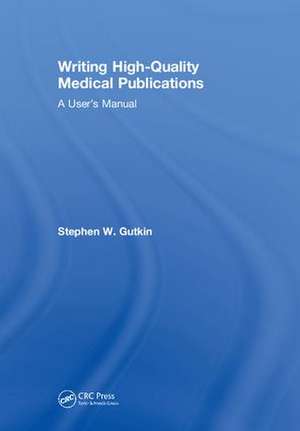Writing High-Quality Medical Publications: A User's Manual
Autor Stephen Gutkinen Limba Engleză Hardback – 6 iul 2018
| Toate formatele și edițiile | Preț | Express |
|---|---|---|
| Paperback (1) | 289.16 lei 6-8 săpt. | |
| CRC Press – 24 aug 2018 | 289.16 lei 6-8 săpt. | |
| Hardback (1) | 1051.35 lei 6-8 săpt. | |
| CRC Press – 6 iul 2018 | 1051.35 lei 6-8 săpt. |
Preț: 1051.35 lei
Preț vechi: 1286.91 lei
-18% Nou
Puncte Express: 1577
Preț estimativ în valută:
201.17€ • 210.64$ • 166.86£
201.17€ • 210.64$ • 166.86£
Carte tipărită la comandă
Livrare economică 10-24 aprilie
Preluare comenzi: 021 569.72.76
Specificații
ISBN-13: 9781138558809
ISBN-10: 113855880X
Pagini: 512
Ilustrații: 256
Dimensiuni: 178 x 254 mm
Greutate: 0.05 kg
Ediția:1
Editura: CRC Press
Colecția CRC Press
ISBN-10: 113855880X
Pagini: 512
Ilustrații: 256
Dimensiuni: 178 x 254 mm
Greutate: 0.05 kg
Ediția:1
Editura: CRC Press
Colecția CRC Press
Public țintă
Academic and Professional ReferenceCuprins
1. Principles and Examples of Quality in Medical Communications. 2. Drafting the Manuscript: Step-by-Step Guidelines and Exercises. 3. Biostatistics: Issues in Study Design, Analysis, and Reporting. 4. Best Practices: Consensus Recommendations and Standards to Prepare High-Quality, Ethical, Transparently Disclosed Manuscripts for Journal Publication. Appendix 1. Minimum Clinically Important Differences (MCIDs) in Patient-Reported Outcomes (PROs). Appendix 2. Probability Distribution Data Tables to Compute p Values. Appendix 3. Common Abbreviations in Clinical and Pharmaceutical Sciences.
Notă biografică
Stephen W. Gutkin is a medical communications professional who has 30 years of experience in medical writing, editing, and editorial management, and publication planning and execution. A coauthor of 14 papers in peer-reviewed journals, Mr. Gutkin served as President of Rete Biomedical Communications Corp. for 23 years, during which the organization consulted widely with industry and academia. A summa cum laude graduate of Duke University, Mr. Gutkin served as arts critic for the Brooklyn Paper; research scientist for a toxicology laboratory that also assayed psychiatric biomarkers; and as copy chief with McGraw-Hill Healthcare (New York). He has delivered invited lectures on medical writing at Johnson & Johnson and the Center for Business Intelligence (now CBINET). Mr. Gutkin is a member of the American Association for the Advancement of Science, American Medical Writers Association, International Society for Pharmacoeconomics and Outcomes Research, and The Phi Beta Kappa. He resides in Midland Park New Jersey, with his wife, son, and colorful pet managerie.
Recenzii
"[A] treasure that offers guidance to help scientific communicators at virtually any skill level elevate their games... This text should be a core component of graduate- and medical-school curricula. I recommend [it] without hesitation as an essential guide and reference text for any clinician or scientist and his or her institution, collaborators, and students."
–Sara B.Glickstein, PhD, Preventive Medicine 2020;134:106037
"This is an excellent resource for those in the field of medical editing/medical writing who seek to publish high quality papers and textbooks. The author's background reflects his extensive knowledge and expertise in this field. {...} This book provides a medical writer's perspective and it contains numerous pearls for novice and veteran writers alike. I hope that every library shelf offers this treasure for aspiring writers to find."
Klara K Papp, PhD, Case Western Reserve University School of Medicine.
The "Gutkin Manual"-- setting the standard for medical writing
Everything about Writing High-Quality Medical Publications raises the bar on what a user’s guide should be. It's not only a compendium of the nitty-gritty, but a navigation aide to the medical writer's highest mission. The author, Stephen W. Gutkin, reaches for the North Star of professionalism here. . .and wants his readers to find their way there as well. Here’s a writer taking you beyond the perfunctory and the merely informational--though you get an array of helpful organizational tools and checklists to optimize manuscript quality and useful reference material. But, in ways rarely found, this eponymous “Gutkin Manual” gives both the novice and veteran medical writer crucial insights on a writer's first principle: to write convincingly with utmost credibility. It’s an “art and science,” as Gutkin puts it, and he tours us through an interesting professional landscape—from how to handle the basics of submitting a paper to a peer-reviewed journal to organizing a study and testing an hypothesis to keeping the integrity of the process in an especially-fraught and ruthlessly competitive commercial enterprise with many points-of-view to juggle.
Gutkin might suggest I leave out this phrase at the end of this sentence, which borders on the banal, but one thing is true: A writer’s manual inevitably calls upon a reviewer to say a thing or two about the writing. Gutkin—witty, deft, wielding an eclectic vocabulary—holds his readers’ attention with linguistic legerdemain. He’s masterly on so many topics—from complex biostatistical tests to ethical transparency. He's careful to include choice insights into the gravitas of clarity. Just appreciate this deceptively simple question he asks of his readers in his section on conclusions: What is the single statement that will convey the most lasting meaning? We can also watch over Gutkin's shoulder as he re-writes prolix selections from published works, showing you the importance of keeping that editing scalpel close at hand. And, finally, the book is peppered with quotable nuggets he’s collected over the years that, frankly, make enjoyment one of this book's key attributes—beyond its status as (likely) the best existing overview to medical writing. You just don’t expect bon mots from John Updike and Henry David Thoreau and the Beatles, but that is what you get in the "Gutkin manual." In the end, it rises above being just a user’s manual to being an remarkable guide to a complex, evolving profession that demands extraordinary verbal skill, analytical acumen, scientific understanding, and marketplace savvy. The book deserves a place on every medical writing professional's bookshelf. But more than that, it deserves underlining, marginalia, dog-earing, and, perhaps, that occasional re-reading to remind the medical-writing professional just how his or her chosen craft can be done at its best. If I were you, I’d buy one for myself and send another to a colleague.
-Jeff Girion
"Writing High-Quality Medical Publications: A User’s Manual is a practical and comprehensive guide to the topic. As an excerpt illustrates, the author knows how to write.
The book includes four chapters: 1. Principles and examples of quality in medical communications 2. Drafting the manuscript: Step-by-step guidelines and exercises 3. Biostatistics: Issues in study design, analysis and reporting 4. Best practices: Consensus recommendations and standards to prepare high-quality ethical, transparently disclosed manuscripts for journal publication The fourth chapter includes 60 detailed quality-control forms and checklists for six different medical publication topics, including randomized clinical trials, observational studies, and systematic literature reviews."
Norman M. Goldfarb, Managing Director of First Clinical Research LLC, a provider of clinical research information services, Journal of Clinical Research Best Practices, Vol. 14, No. 11, November 2018
The "Bible" for Medical Writers:
At last a user’s manual for writers of medical publications. Writing High Quality Medical Publications explains and contextualizes the key elements of successful medical papers - compelling content, articulation of process and procedure, clear and consumable use and presentation of data, and, of course, understanding of and adherence to ethical standards of medical writing. A must have for medical writers and editors.
--Andus D. Baker
The "Gutkin Manual"-- setting the standard for medical writing
Everything about Writing High-Quality Medical Publications raises the bar on what a user’s guide should be. It's not only a compendium of the nitty-gritty, but a navigation aide to the medical writer's highest mission. The author, Stephen W. Gutkin, reaches for the North Star of professionalism here. . .and wants his readers to find their way there as well. Here’s a writer taking you beyond the perfunctory and the merely informational--though you get an array of helpful organizational tools and checklists to optimize manuscript quality and useful reference material. But, in ways rarely found, this eponymous “Gutkin Manual” gives both the novice and veteran medical writer crucial insights on a writer's first principle: to write convincingly with utmost credibility. It’s an “art and science,” as Gutkin puts it, and he tours us through an interesting professional landscape—from how to handle the basics of submitting a paper to a peer-reviewed journal to organizing a study and testing an hypothesis to keeping the integrity of the process in an especially-fraught and ruthlessly competitive commercial enterprise with many points-of-view to juggle.
Gutkin might suggest I leave out this phrase at the end of this sentence, which borders on the banal, but one thing is true: A writer’s manual inevitably calls upon a reviewer to say a thing or two about the writing. Gutkin—witty, deft, wielding an eclectic vocabulary—holds his readers’ attention with linguistic legerdemain. He’s masterly on so many topics—from complex biostatistical tests to ethical transparency. He's careful to include choice insights into the gravitas of clarity. Just appreciate this deceptively simple question he asks of his readers in his section on conclusions: What is the single statement that will convey the most lasting meaning? We can also watch over Gutkin's shoulder as he re-writes prolix selections from published works, showing you the importance of keeping that editing scalpel close at hand. And, finally, the book is peppered with quotable nuggets he’s collected over the years that, frankly, make enjoyment one of this book's key attributes—beyond its status as (likely) the best existing overview to medical writing. You just don’t expect bon mots from John Updike and Henry David Thoreau and the Beatles, but that is what you get in the "Gutkin manual." In the end, it rises above being just a user’s manual to being an remarkable guide to a complex, evolving profession that demands extraordinary verbal skill, analytical acumen, scientific understanding, and marketplace savvy. The book deserves a place on every medical writing professional's bookshelf. But more than that, it deserves underlining, marginalia, dog-earing, and, perhaps, that occasional re-reading to remind the medical-writing professional just how his or her chosen craft can be done at its best. If I were you, I’d buy one for myself and send another to a colleague.
Jeff Girion
"Writing High-Quality Medical Publications: A User’s Manual is a practical and comprehensive guide to the topic. As an excerpt illustrates, the author knows how to write.
The book includes four chapters: 1. Principles and examples of quality in medical communications 2. Drafting the manuscript: Step-by-step guidelines and exercises 3. Biostatistics: Issues in study design, analysis and reporting 4. Best practices: Consensus recommendations and standards to prepare high-quality ethical, transparently disclosed manuscripts for journal publication The fourth chapter includes 60 detailed quality-control forms and checklists for six different medical publication topics, including randomized clinical trials, observational studies, and systematic literature reviews."
Norman M. Goldfarb, Managing Director of First Clinical Research LLC, a provider of clinical research information services, Journal of Clinical Research Best Practices, Vol. 14, No. 11, November 2018
The "Bible" for Medical Writers:
At last a user’s manual for writers of medical publications. Writing High Quality Medical Publications explains and contextualizes the key elements of successful medical papers - compelling content, articulation of process and procedure, clear and consumable use and presentation of data, and, of course, understanding of and adherence to ethical standards of medical writing. A must have for medical writers and editors.
--Andus D. Baker
"I hope that every library shelf offers this treasure for aspiring writers to find."
-Klara K. Papp, PhD, Case Western Reserve University School of Medicine.
Overall, Writing High-Quality Medical Publications: A User's Manual is an excellent resource for medical writers. I believe that reading the book can help any medical writer have his/her first manuscript get published in a medical journal. Since I can’t point out anything bad about the book, I rate this book 4 out of 4 stars. While the book is intended for medical writers, I can recommend it to manuscript writers working in engineering, and the natural and social sciences.
Raik Yuu - OnlineBookClub.org
"In summary, “The Gutkin Manual” teaches us that high-quality writing reflects our critical thinking and signals our credibility and capability. If cogent writing is the sister of well-designed and performed studies, this text should be a core component of graduate and medical-school curricula. Mr. Gutkin's lessons and perspective allow us to benefit from his substantial experience beyond the frequent norm of a “day-to-day slog” in industry, academia, and agencies. The text will support most professionals seeking to interpret and report findings to a broad professional audience of peer-reviewed journal readers. Hence, I recommend “The Gutkin Manual” without hesitation as an essential guide and reference text for any clinician or scientist and his or her institution, collaborators, and students."
Sara B.Glickstein, Science Direct
–Sara B.Glickstein, PhD, Preventive Medicine 2020;134:106037
"This is an excellent resource for those in the field of medical editing/medical writing who seek to publish high quality papers and textbooks. The author's background reflects his extensive knowledge and expertise in this field. {...} This book provides a medical writer's perspective and it contains numerous pearls for novice and veteran writers alike. I hope that every library shelf offers this treasure for aspiring writers to find."
Klara K Papp, PhD, Case Western Reserve University School of Medicine.
The "Gutkin Manual"-- setting the standard for medical writing
Everything about Writing High-Quality Medical Publications raises the bar on what a user’s guide should be. It's not only a compendium of the nitty-gritty, but a navigation aide to the medical writer's highest mission. The author, Stephen W. Gutkin, reaches for the North Star of professionalism here. . .and wants his readers to find their way there as well. Here’s a writer taking you beyond the perfunctory and the merely informational--though you get an array of helpful organizational tools and checklists to optimize manuscript quality and useful reference material. But, in ways rarely found, this eponymous “Gutkin Manual” gives both the novice and veteran medical writer crucial insights on a writer's first principle: to write convincingly with utmost credibility. It’s an “art and science,” as Gutkin puts it, and he tours us through an interesting professional landscape—from how to handle the basics of submitting a paper to a peer-reviewed journal to organizing a study and testing an hypothesis to keeping the integrity of the process in an especially-fraught and ruthlessly competitive commercial enterprise with many points-of-view to juggle.
Gutkin might suggest I leave out this phrase at the end of this sentence, which borders on the banal, but one thing is true: A writer’s manual inevitably calls upon a reviewer to say a thing or two about the writing. Gutkin—witty, deft, wielding an eclectic vocabulary—holds his readers’ attention with linguistic legerdemain. He’s masterly on so many topics—from complex biostatistical tests to ethical transparency. He's careful to include choice insights into the gravitas of clarity. Just appreciate this deceptively simple question he asks of his readers in his section on conclusions: What is the single statement that will convey the most lasting meaning? We can also watch over Gutkin's shoulder as he re-writes prolix selections from published works, showing you the importance of keeping that editing scalpel close at hand. And, finally, the book is peppered with quotable nuggets he’s collected over the years that, frankly, make enjoyment one of this book's key attributes—beyond its status as (likely) the best existing overview to medical writing. You just don’t expect bon mots from John Updike and Henry David Thoreau and the Beatles, but that is what you get in the "Gutkin manual." In the end, it rises above being just a user’s manual to being an remarkable guide to a complex, evolving profession that demands extraordinary verbal skill, analytical acumen, scientific understanding, and marketplace savvy. The book deserves a place on every medical writing professional's bookshelf. But more than that, it deserves underlining, marginalia, dog-earing, and, perhaps, that occasional re-reading to remind the medical-writing professional just how his or her chosen craft can be done at its best. If I were you, I’d buy one for myself and send another to a colleague.
-Jeff Girion
"Writing High-Quality Medical Publications: A User’s Manual is a practical and comprehensive guide to the topic. As an excerpt illustrates, the author knows how to write.
The book includes four chapters: 1. Principles and examples of quality in medical communications 2. Drafting the manuscript: Step-by-step guidelines and exercises 3. Biostatistics: Issues in study design, analysis and reporting 4. Best practices: Consensus recommendations and standards to prepare high-quality ethical, transparently disclosed manuscripts for journal publication The fourth chapter includes 60 detailed quality-control forms and checklists for six different medical publication topics, including randomized clinical trials, observational studies, and systematic literature reviews."
Norman M. Goldfarb, Managing Director of First Clinical Research LLC, a provider of clinical research information services, Journal of Clinical Research Best Practices, Vol. 14, No. 11, November 2018
The "Bible" for Medical Writers:
At last a user’s manual for writers of medical publications. Writing High Quality Medical Publications explains and contextualizes the key elements of successful medical papers - compelling content, articulation of process and procedure, clear and consumable use and presentation of data, and, of course, understanding of and adherence to ethical standards of medical writing. A must have for medical writers and editors.
--Andus D. Baker
The "Gutkin Manual"-- setting the standard for medical writing
Everything about Writing High-Quality Medical Publications raises the bar on what a user’s guide should be. It's not only a compendium of the nitty-gritty, but a navigation aide to the medical writer's highest mission. The author, Stephen W. Gutkin, reaches for the North Star of professionalism here. . .and wants his readers to find their way there as well. Here’s a writer taking you beyond the perfunctory and the merely informational--though you get an array of helpful organizational tools and checklists to optimize manuscript quality and useful reference material. But, in ways rarely found, this eponymous “Gutkin Manual” gives both the novice and veteran medical writer crucial insights on a writer's first principle: to write convincingly with utmost credibility. It’s an “art and science,” as Gutkin puts it, and he tours us through an interesting professional landscape—from how to handle the basics of submitting a paper to a peer-reviewed journal to organizing a study and testing an hypothesis to keeping the integrity of the process in an especially-fraught and ruthlessly competitive commercial enterprise with many points-of-view to juggle.
Gutkin might suggest I leave out this phrase at the end of this sentence, which borders on the banal, but one thing is true: A writer’s manual inevitably calls upon a reviewer to say a thing or two about the writing. Gutkin—witty, deft, wielding an eclectic vocabulary—holds his readers’ attention with linguistic legerdemain. He’s masterly on so many topics—from complex biostatistical tests to ethical transparency. He's careful to include choice insights into the gravitas of clarity. Just appreciate this deceptively simple question he asks of his readers in his section on conclusions: What is the single statement that will convey the most lasting meaning? We can also watch over Gutkin's shoulder as he re-writes prolix selections from published works, showing you the importance of keeping that editing scalpel close at hand. And, finally, the book is peppered with quotable nuggets he’s collected over the years that, frankly, make enjoyment one of this book's key attributes—beyond its status as (likely) the best existing overview to medical writing. You just don’t expect bon mots from John Updike and Henry David Thoreau and the Beatles, but that is what you get in the "Gutkin manual." In the end, it rises above being just a user’s manual to being an remarkable guide to a complex, evolving profession that demands extraordinary verbal skill, analytical acumen, scientific understanding, and marketplace savvy. The book deserves a place on every medical writing professional's bookshelf. But more than that, it deserves underlining, marginalia, dog-earing, and, perhaps, that occasional re-reading to remind the medical-writing professional just how his or her chosen craft can be done at its best. If I were you, I’d buy one for myself and send another to a colleague.
Jeff Girion
"Writing High-Quality Medical Publications: A User’s Manual is a practical and comprehensive guide to the topic. As an excerpt illustrates, the author knows how to write.
The book includes four chapters: 1. Principles and examples of quality in medical communications 2. Drafting the manuscript: Step-by-step guidelines and exercises 3. Biostatistics: Issues in study design, analysis and reporting 4. Best practices: Consensus recommendations and standards to prepare high-quality ethical, transparently disclosed manuscripts for journal publication The fourth chapter includes 60 detailed quality-control forms and checklists for six different medical publication topics, including randomized clinical trials, observational studies, and systematic literature reviews."
Norman M. Goldfarb, Managing Director of First Clinical Research LLC, a provider of clinical research information services, Journal of Clinical Research Best Practices, Vol. 14, No. 11, November 2018
The "Bible" for Medical Writers:
At last a user’s manual for writers of medical publications. Writing High Quality Medical Publications explains and contextualizes the key elements of successful medical papers - compelling content, articulation of process and procedure, clear and consumable use and presentation of data, and, of course, understanding of and adherence to ethical standards of medical writing. A must have for medical writers and editors.
--Andus D. Baker
"I hope that every library shelf offers this treasure for aspiring writers to find."
-Klara K. Papp, PhD, Case Western Reserve University School of Medicine.
Overall, Writing High-Quality Medical Publications: A User's Manual is an excellent resource for medical writers. I believe that reading the book can help any medical writer have his/her first manuscript get published in a medical journal. Since I can’t point out anything bad about the book, I rate this book 4 out of 4 stars. While the book is intended for medical writers, I can recommend it to manuscript writers working in engineering, and the natural and social sciences.
Raik Yuu - OnlineBookClub.org
"In summary, “The Gutkin Manual” teaches us that high-quality writing reflects our critical thinking and signals our credibility and capability. If cogent writing is the sister of well-designed and performed studies, this text should be a core component of graduate and medical-school curricula. Mr. Gutkin's lessons and perspective allow us to benefit from his substantial experience beyond the frequent norm of a “day-to-day slog” in industry, academia, and agencies. The text will support most professionals seeking to interpret and report findings to a broad professional audience of peer-reviewed journal readers. Hence, I recommend “The Gutkin Manual” without hesitation as an essential guide and reference text for any clinician or scientist and his or her institution, collaborators, and students."
Sara B.Glickstein, Science Direct
Descriere
This comprehensive and supportive guide helps to get your paper accepted—and by the journal of first choice. Elucidating pivotal principles of quality, and biostatistics, and informed by the belief that scientific writing can be engaging, elegant, and memorable, this volume will help you to enhance both the structure and substance of manuscripts.





















